Phytoplanktons
Phytoplanktons or algae are microscopic, single-celled plants that live
in the sea. They constitute the base of the marine food web, using
sunlight to convert carbon dioxide into food molecules by the process
of photosynthesis. Phytoplankton concentration is correlated to
the ocean primary production. The identification and monitoring
of phytoplankton concentration are often considered as a viable
means to locate new fishing grounds.
Examples of phytoplanktons
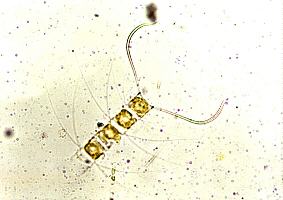 diatoms diatoms
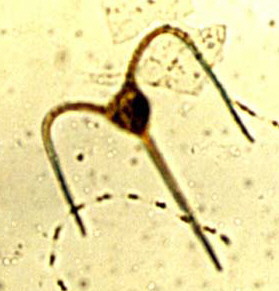 A type of dinoflagellate A type of dinoflagellate
|
Harmful Algal Blooms
Under certain favourable conditions, algae in the sea multiply to high
concentrations forming what is known as an algal bloom. Some of
the algae appear reddish in colour. Hence, they are commonly known
as Red Tides. During an algal bloom event, there is a high cell
concentration of phytoplankton, usually dominated by a particular
algal species. These blooms are commonly observed in coastal waters
around the globe.
Most species of algae are not harmful. In cases where an algal bloom is detrimental to human and other marine life, it is referred to as a harmful algal bloom (HAB).
Algal blooms may cause harm by the following mechanisms:
- The dense layer of algae near to the water surface blocks sunlight from reaching the other aquatic life.
- When bloom collapses, the microbial respiration on the dead and decaying cells can lead to reduced oxygen concentrations that can kill fish and other aquatic organisms due to lack of oxygen.
- In situations whereby a bloom is dominated by toxic algal species, fish and shellfish can be poisoned by the toxins.
- HABs can cause severe damage to the fishing and aquaculture industry due to fish kills.
- The toxins from HAB can accumulate in the food chain and eventually be consumed by humans to cause paralytic or diarrhetic shellfish poisoning.
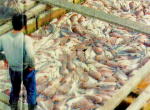
|
A photograph showing dead fishes in a fish farm killed during a red tide event at Lamma Island, Hong Kong (Source: The Straits Times, April 13, 1998). |
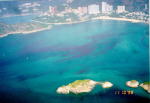
|
An aerial photograph showing the red tide situation in the Repulse Bay of Hong Kong on 10th November 1998. The reddish linear patches are locations of red tides. (Courtesy of Mr Edwin Ginn, Hong Kong Observatory, the Government of the Hong Kong Special Administrative Region) |
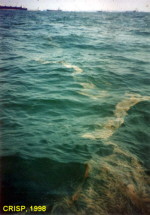
|
A minor bloom of Trichodesmium observed in Singapore Water, off Bedok Coast, on 31 July 1997 |
|
Red Tides in Southeast and East Asia
Algal blooms occur regularly in many parts of Southeast Asia. Some of
the common bloom species are known to be harmful or even toxic.
For example, blooms of Pyrodinium bahamense var. compressum have
occurred in the Manila Bay of Philippines, and near Brunei. Paralytic
shellfish poisonings have also been reported in Sabah, Malaysia.
It is suspected that blooms are occurring more frequently in recent
years. They have also spread to new locations (e.g. Hong Kong) where
no significant bloom has been reported before.
Manila Bay
Red tide is almost an annual event (usually from May to August) in the
Manila Bay, Philippines, especially near the Bataan and Cavite regions.
The toxic cases have been attributed to Pyrodinium blooms. In 1998,
at least 2 casualties due to consumption of contaminated shellfish
have been reported. There was no report of harmful algal bloom in
1999. In May 2000, Pyrodinium bahamense was again detected in parts
of Manila Bay in Bataan, Cavite and Navotas. The toxic algal density
and red tide toxin present in shellfish gathered from these areas,
however, remained within the tolerable level (i.e. algal density
< 500 cells per liter of sea water, toxin level < 40 micrograms
per 100 grams of shellfish meat). Nevertheless, the Department of
Health cautioned the public against eating shellfish (Philippine
Star, 23 May 2000).
Sabah Coast
Pyrolytic shellfish poisoning occurs from time to time in the state of
Sabah, Malaysia. In December 1999, Sabah Fisheries Department issued
warnings that the waters of Sabah, especially in Kuala Penyu and
Kota Kinabalu, were contaminated by the red-tide toxin. This prompted
Brunei to immediately ban the import of fish, such as mackerel and
sardines, from Sabah (Straits Times, 10 Dec 1999). In March 2000,
the Health Ministry issued a health alert asking the people in Sabah
to adhere to the Fisheries Department's advice not to fish or consume
shellfish or swim in red tide areas. The alert was issued due to
the prevalence of toxin in samples tested from many parts of Sabah
including from Kota Kinabalu, Kuala Penyu, Beaufort, Papar, Kudat,
Sandakan, Tawau, Kunak and Lahad Datu (Star Online, 6 Mar 2000).
Hong Kong and East China Coast
In Hong Kong, the red tides which occurred between mid-March and mid-April 1998
resulted in the loss of 32 million US dollars in fish kill damage.
Using satellite imagery, Yin et al. (1999) traced the spreading
of harmful algal blooms from the South China coast east of Hong
Kong in Nov 1997, to Hong Kong in Apr 1998. The movement of the
algal blooms along the South China coast was attributed to the 1997-98
El Nino event. Red tide events have been increasing off the Chinese
coast since the 1990s. A total of 200 red tides have been registered
during the past decade with 45 major red tides occurring over the
past three years in the Bohai Sea, the Yellow Sea, the East China
Sea and the South China Sea. The economic loss due to these red
tides has been reported to be 240 million US dollars. The accumulation
of organic pollutants due to increasing pollution from industrial
waste water has been cited as a reason for the increasing red tide
incidence (Xinhua News Agency, 25 May 2000). |
Some Reported Red Tide Incidences In Southeast And East Asia, 1998 - 2000
|
Location
|
Time
|
Event
|
|
Hong Kong, China
|
Mar/Apr 1998
|
A massive red-tide episode affected
Hong Kong Fishery Industry (1000 fish farms). The estimated loss is around 32
million US dollars.
|
|
Sabah, Malaysia
|
May 1998
|
Shell fish found to contain toxin at
5 times hazardous level.
|
|
Manila Bay, Philippines
|
Aug 1998
|
Red tide detected in Manila Bay
(Toxic species: Pyrodinium Bahamense). At least 2 persons died after eating
polluted shell fish.
|
|
Sabah, Malaysia*
|
Dec 1999
|
Sabah Fisheries Department issued
warning on red tide toxin contamination of the waters of Sabah, especially in
Kuala Penyu and Kota Kinabalu.
|
|
Sabah, Malaysia*
|
Mar 2000
|
The Fisheries Department banned the
export of cockles from Sabah due to a red tide outbreak. Samples of sea water
and cockles collected off Sabah showed a dangerous level of toxicity at 80 mg/mg.
|
|
Zhejiang, China*
|
May 2000
|
A large red tide (about 1000 sq km)
was spotted off the coast of east China's Zhejiang Province in the Zhoushan
area between the north latitude of 28 and 29 degrees.
|
|
Manila, Philippines
|
May 2000
|
Pyrodinium bahamense was detected in
parts of Manila Bay in Bataan, Cavite and Navotas. The toxic algal density
and red tide toxin present in shellfish gathered from these areas remained
within the tolerable level
|
|
Guangdong, China*
|
Jun 2000
|
A red tide was spotted in the sea off
Nan'ao County, in Guangdong Province
|
|
|
(i) Red Tides Monitoring;
(ii) Ocean Colour Remote Sensing Satellite Sensors;
|
 diatoms
diatoms  A type of dinoflagellate
A type of dinoflagellate


